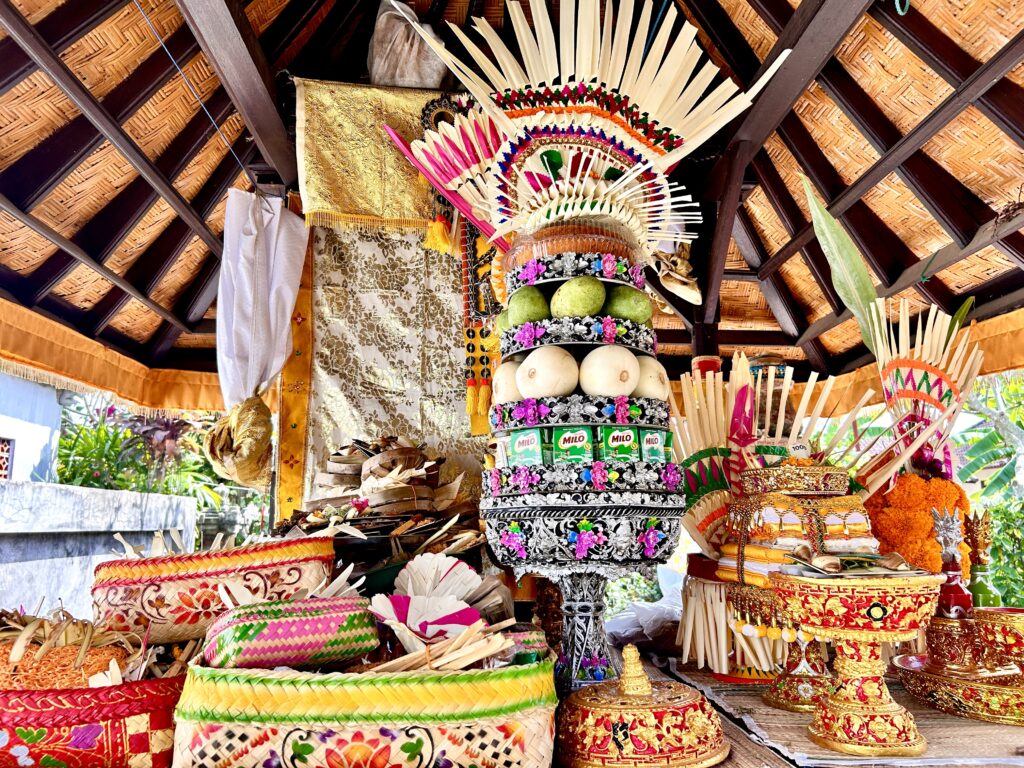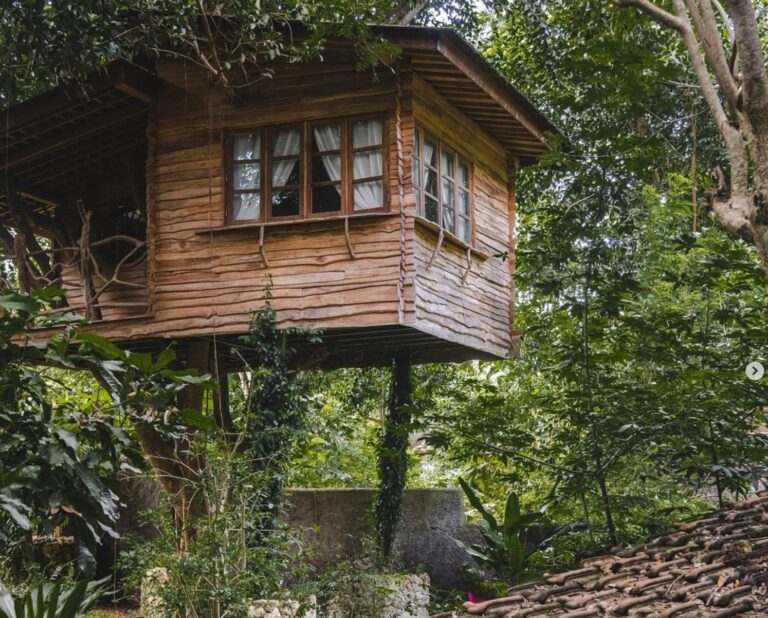Across Bali, the sound of gamelan and the scent of incense often mean one thing: a temple ceremony is underway.
Known as Odalan, these celebrations mark the anniversary of each temple, a time when communities come together to honour the gods and renew the temple’s spiritual energy.
Every Odalan celebration blends devotion and festivity: offerings are prepared, prayers are recited, and traditional music and dance fill the temple courtyard.
For the Balinese, it’s both a sacred duty and a joyful reminder of life’s balance, where faith, art, and community move as one.
TL;DR
Odalan is a temple anniversary celebration that takes place every 210 days in Bali, following the island’s Pawukon calendar.
Each temple has its own special day, celebrating the renewal of its spirit and the bond it shares with the local people. It’s a time when prayer, music, and dance fill the air, and faith feels alive in every corner of the temple grounds.
In the days leading up, families prepare offerings, decorate shrines with flowers, and hang bright fabrics that flutter in the breeze. When the ceremony begins, the sound of gamelan carries through the village and the scent of incense drifts through the crowd.
For visitors, it’s one of the most authentic ways to feel Bali’s rhythm, a sacred celebration that blends devotion, art, and everyday life in perfect balance.
What Is Odalan?

Odalan is the temple’s birthday, a sacred anniversary that honours the day it was first blessed and brought to life through ritual.
It marks the renewal of a temple’s spiritual essence and its ongoing role as the heart of community life.
Each Odalan brings together faith, art, and togetherness in a cycle that never really ends.
From small shrines tucked within family compounds to grand temple complexes that serve entire villages, every temple has its own Odalan, celebrated every 210 days according to the Balinese Pawukon calendar.
It’s not only about worship but renewal, of connection, balance, and the shared rhythm that ties the Balinese to their gods, their ancestors, and the land itself.
It’s worth noting that this celebration is often referred to as “Piodolan”, which is the formal language. “Odalan” is a contraction.
Significance To The Balinese People
For the Balinese people, Odalan is more than a religious duty; it’s a reaffirmation of community and identity. Every generation grows up participating, learning that spiritual life is not separate from daily life; it’s interwoven with it.
Villagers come together in preparation and celebration, each person taking on a role, from crafting offerings to playing in the gamelan orchestra. Through these acts, they honour the Tri Hita Karana philosophy, maintaining harmony between the divine, people, and nature.
The significance of Odalan lies in its continuity. It connects families, neighbours, and generations in shared purpose, reminding everyone that their temple is a living space, not just stone and ritual, but the centre of belonging and gratitude.
It’s not only a significant religious event, but also a cultural and communal gathering.
When Do Odalan Celebrations Take Place
Odalan dates are determined by the Pawukon calendar: a 210-day cycle made up of multiple overlapping weeks. Because each temple follows its own Odalan date of consecration, there’s a temple festival happening somewhere in Bali almost every day.
Major temples might host large-scale celebrations lasting several days, with vibrant processions, traditional dance, and communal feasting. Smaller shrines often keep things simpler but equally heartfelt, marked by prayer, offerings, and music.
Visitors travelling through Bali are likely to come across these celebrations often, especially in rural areas. For locals, the steady rhythm of Odalan keeps life connected to the spiritual calendar, a reminder that time in Bali isn’t measured only by months or years, but by devotion, ceremony, and renewal.
Preparing For The Celebration
Preparation for an Odalan begins days in advance, often transforming the entire village into a hive of activity. Women weave young coconut leaves into canang sari offerings, men build bamboo penjor poles to line the temple entrance, and children help decorate altars with flowers and other symbolic items.
It’s a time of collaboration and purpose. Elders guide the younger generation, passing on rituals, chants, and customs that ensure the celebration unfolds with the right balance of respect and joy.
Food is prepared, temple grounds are cleaned, and sacred objects are readied for blessing. By the time the first sound of the gamelan echoes through the air, every detail reflects a shared devotion.
The preparation itself becomes a spiritual act, one that strengthens the community as much as it honours the gods.
Offerings And Symbolic Decorations

At the heart of every Odalan are the offerings: colourful, intricate, and deeply symbolic. Crafted from natural materials like banana leaves, coconut, flowers, and rice cakes, they express gratitude to the divine and invite blessings in return.
Larger offerings, called gebogan, are stacked high with fruit, cakes, and flowers, carried gracefully on women’s heads during temple processions. Every detail holds meaning, from the colours used to the placement of each element.
The temple is dressed in vibrant fabrics of red, gold, white, and yellow; colours representing different deities and elements. Together, these offerings and decorations transform the temple into a living expression of faith, beauty, and balance, where nothing is purely ornamental; everything is sacred.
Rituals And Balinese Spirituality
Odalan rituals blend ancient Hindu beliefs with uniquely Balinese interpretations of spirituality. Ceremonies include prayers led by priests, the sprinkling of holy water, and the blessing of offerings. The air fills with incense smoke, the rhythmic pulse of gamelan, and the murmur of devotion.
For the Balinese, these acts maintain spiritual harmony: keeping balance between the seen world (sekala) and the unseen (niskala). The rituals serve as reminders that both exist side by side, shaping life on the island in subtle and profound ways.
Even for those watching quietly from the edge of the temple courtyard, there’s a palpable sense of peace and purpose. Every prayer and every offering is meticulously crafted and brings renewal to the island’s spiritual heartbeat.
Music, Dance And Cultural Performances

No Odalan ceremony is complete without music and dance, the soul of Balinese culture made visible. The steady rhythm of gamelan echoes through temple courtyards, setting the pace for dancers who bring ancient stories to life.
Traditional dance performances such as the Legong, Rejang or Barong dance are not staged for an audience but offered to the gods as acts of devotion. Each movement carries meaning: protection, gratitude, balance. The performers, often community members from the local banjar, train for weeks to prepare.
Costumes shimmer in gold and red under temple lanterns, and the hypnotic clang of metallophones fills the night air. For locals, these cultural performances are a way of keeping tradition alive, blending art and spirituality in a celebration that reminds everyone that beauty, faith, and life are one and the same.
The Social Heart Of Odalan
Beyond the prayers, rituals, and dance performances, every Odalan festival is a communal event that strengthens the social bonds within a village.
The temple anniversary celebration brings together people of all ages, each contributing to the preparations and festivities in their own way. It’s this spirit of cooperation that makes Bali’s cultural life feel so alive and connected.
Villagers share food, stories, and laughter beneath the fluttering penjor poles, creating a vibrant tapestry of colour, music, and devotion. These moments reflect the Balinese philosophy of harmony, helping maintain spiritual balance and a harmonious relationship between humans, nature, and the divine.
Odalan festivities are not just about faith; they celebrate friendship, heritage, and unity. Every temple festival becomes a reminder of deep respect for tradition and community, a living example of how the culture continues to thrive through shared purpose and joy.
Where Odalan Celebrations Take Place
Odalan celebrations unfold in temples all across Bali, from grand sea temples perched on cliffs to the small family shrines found within traditional compounds.
Village temples often host the most vibrant Odalan festivals, drawing community members together for days of prayer, dance, and devotion. Temple grounds are dressed with bright umbrellas, sacred cloth, and pennants that sway gently in the wind, marking the sacred space as ready for divine presence.
Each Odalan ceremony involves specific rituals and local traditions that pay homage to the gods and honour the temple’s consecration. No matter the size of the temple, the sense of community spirit is unmistakable – a living tradition that celebrates both faith and togetherness in a truly Balinese way.
How To Get Involved
For visitors, joining an Odalan offers a deeper appreciation of Balinese culture and spirituality, but it must be approached with cultural sensitivity and respect. These are not tourist shows or staged cultural events, but significant religious ceremonies that hold great cultural importance for local people.
If you’re invited to attend, or show up on a whim seeking blessings, dress respectfully, and if possible, in traditional clothing such as a sarong and sash, and observe local customs quietly. A small donation is always appreciated, as it helps the community maintain the temple and its ongoing celebrations.
Stand back when communal prayers begin, and admire the beautiful offerings, the meticulous decorations, and the festive atmosphere that fills the temple grounds. You’ll see local people in their finest traditional attire, preparing elaborate offerings and taking part in sacred dances; a vivid expression of faith that fosters a sense of belonging and harmony.
For those who approach it with open hearts, an Odalan ceremony is an unforgettable window into the soul of Balinese life.
FAQs
What Is The Meaning Of Odalan?
Odalan means the anniversary of a Balinese temple, the day it was first consecrated and its spirit invited to dwell there.
It’s a time for the community to express gratitude, renew balance, and honour the divine presence that protects the temple and its people.
Why Does The Balinese Calendar Have 210 Days?
The traditional Balinese Pawukon calendar is made up of 210 days, divided into overlapping cycles of different lengths, from one to ten days, that repeat continuously.
Unlike the Gregorian calendar (used for official and day-to-day activities), it does not mark years but measures spiritual and ceremonial rhythm. Each cycle helps determine when festivals like Odalan are held, keeping temple life in harmony with cosmic balance.
What Is The Temple Ceremony In Bali?
The temple ceremony, or Odalan, is a sacred celebration held at temples across Bali.
It combines prayer, offerings, and art – from gamelan music to traditional dance – creating a living expression of devotion and harmony within the community.
What Is Piodalan?
Piodalan is another term for Odalan. The word comes from the Balinese phrase ngodalin, meaning “to have a birthday.”
Every temple has its own Piodalan date, determined by the 210-day Pawukon calendar, and each celebration renews the temple’s spiritual energy.
What Clothes Should I Wear To The Celebration?
Great question!
As always, you should come to the temple dressed in a respectful and modest fashion. No short skirts or shorts, no shoulders on show. Temples are a sacred place, and it’s appreciated when visitors respect this.
But don’t feel shy or intimidated, the local people are more than happy to welcome a new friend. You are not expected to be aware of specific customs; that’s part of what makes Bali such a fantastic place to visit.
Final Thoughts On Odalan
Odalan is at the heart of Balinese Tradition.
Each ceremony renews the bond between people, place, and the divine, reminding the community that a temple is more than stone and prayer; it’s a living space that must be cared for and celebrated.
For visitors, witnessing an Odalan offers a genuine glimpse into Bali’s cultural rhythm.
It’s not a performance, but a way of life; one that continues to shape the island’s identity and spirit, generation after generation.

















